“Wait, there are alternatives to Toptal?”
Turns out there’s more than one way to hire elite developers without mortgaging your office ping-pong table. While Toptal wrote the playbook on premium talent marketplaces (and still dominates boardroom discussions), a new generation of platforms is rewriting the rules.
I’ve spent months test-driving every major hiring platform out there – from corporate talent highways to boutique dev shops. The surprising discovery? That warm, fuzzy feeling of working with top-tier developers doesn’t have to come with enterprise-sized heartburn.
Some platforms focus on speed, others on specialization. A few even manage to do both without requiring a CFO’s approval for every Git commit.
Platforms like Lemon.io have emerged to fill specific gaps. Some offer faster matching with personally vetted developers, while others bring specialized expertise or flexible pricing models.
If you’re looking for a Toptal alternative, then continue reading.
TL/DR:
- Toptal’s “top 3%” claim comes with significant markup pricing (often 30-50% over developer rates) and a mandatory $500 deposit that can be difficult to recover.
- Lemon.io offers comparable developer quality, talent matches within two weeks (sometimes within 24 hours), and specializes in scale-up and startup-focused developers.
- Arc.dev uses AI-powered matching but sometimes sacrifices precision for speed, with pricing similar to Toptal but without the deposit requirement.
- Upwork provides access to affordable talent but requires significant technical screening ability and time investment to find quality developers.
- Fiverr Pro and Gun.io offer specialized developer pools with distinct advantages for specific project types.
Why Seek Toptal Alternatives?
The Premium Price Tag
Toptal owns their premium positioning with confidence, and their rates reflect it. Frontend React developers start at $65-100 hourly, while specialists command $80-200+. Fair enough.
What makes these rates interesting? They include Toptal’s platform fee—a substantial percentage that funds their vetting process and support infrastructure. It’s a model that works brilliantly for companies with enterprise budgets. For others, it prompts the question: does elite talent require elite pricing?
The $500 Hello
Toptal’s trial process begins with a $500 deposit. Yes, it applies to your first invoice. Yes, they’ll return it if you don’t hire. No, they won’t budge on collecting it upfront. For enterprise clients, it’s pocket change. For startups? It’s a discussion with the finance team.
The Enterprise Algorithm
Toptal has mastered enterprise-grade talent matching. Their process excels at exactly what it’s designed for: serving large organizations with structured hiring needs. They’ve built a precise system that delivers:
- Extensive documentation (your legal team will love this)
- Standardized screening (perfect for ISO compliance)
- Predictable timelines (ideal for quarterly planning)
But what if you’re not an enterprise? That’s where alternatives come in.
Top Alternatives to Toptal for Hiring Developers
Lemon.io: Boutique Quality with a Startup & Scale-up Focus
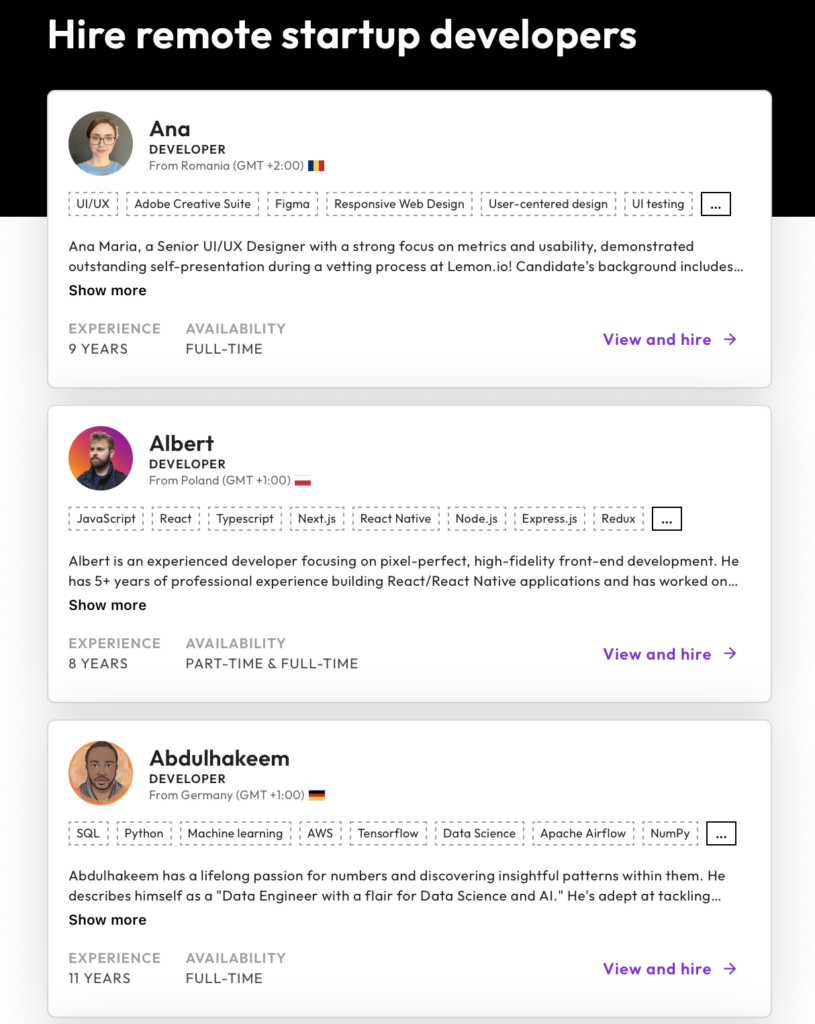
After analyzing multiple platforms, Lemon.io stands out for our specialized focus on providing developers with startup experience. This isn’t just marketing—it’s baked into our vetting process, which explicitly screens for the ability to adapt to changing requirements and fast-paced environments.
Strengths:
- Speed of matching: Most clients receive qualified developer profiles within 1-2 weeks, with some matches happening as quickly as 24 hours. Our focus on quality over speed means we take the time to get the match right.
- Startup-specialized talent: Developers are specifically vetted for experience with early-stage and scale-up companies and the flexibility these require.
- Transparent pricing: Rates typically start at $45/hr with clear fee structures and no hidden costs.
- Personal touch: Our boutique approach means we personally know every developer in our network, resulting in more precise matching.
- Developer-friendly environment: Our boutique size enables better support, lower fees, and less competition—attracting top talent who prefer our platform over larger marketplaces.
- High-touch client service: Our focused approach allows deeper client relationships, precise candidate matching, and rapid problem resolution.
As one client shared:
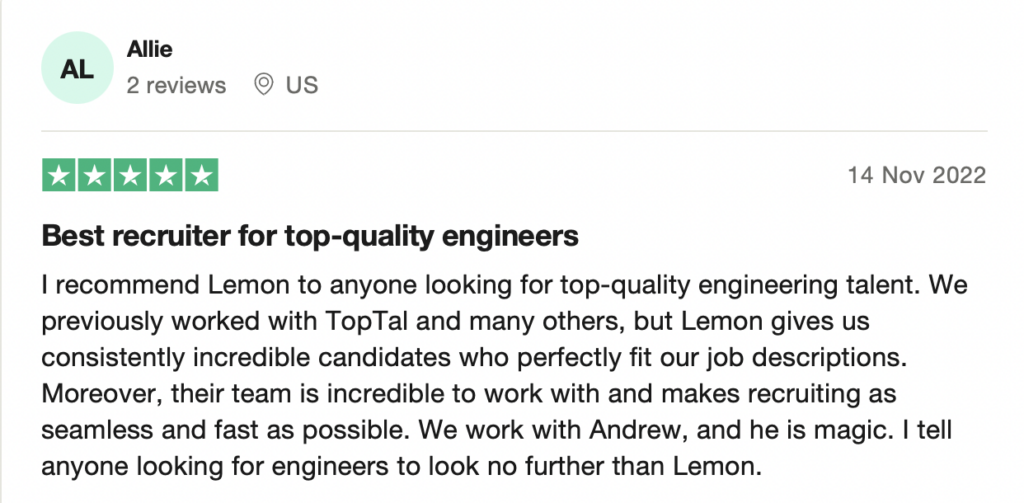
Weaknesses:
- Smaller talent pool: By being selective and focused on certain regions (primarily Eastern Europe), our pool is smaller than Toptal’s global network.
- Limited non-developer roles: While expanding, our primary focus is on developers rather than designers or marketers.
Lemon.io’s most impressive statistic is that 75% of clients hire the first candidate suggested to them—indicating our matching accuracy significantly exceeds industry averages.
And not to toot our own horn (toot, toot!), we have the highest Trustpilot rating of the bunch:

Arc.dev: AI-Powered Matching with Enterprise Appeal
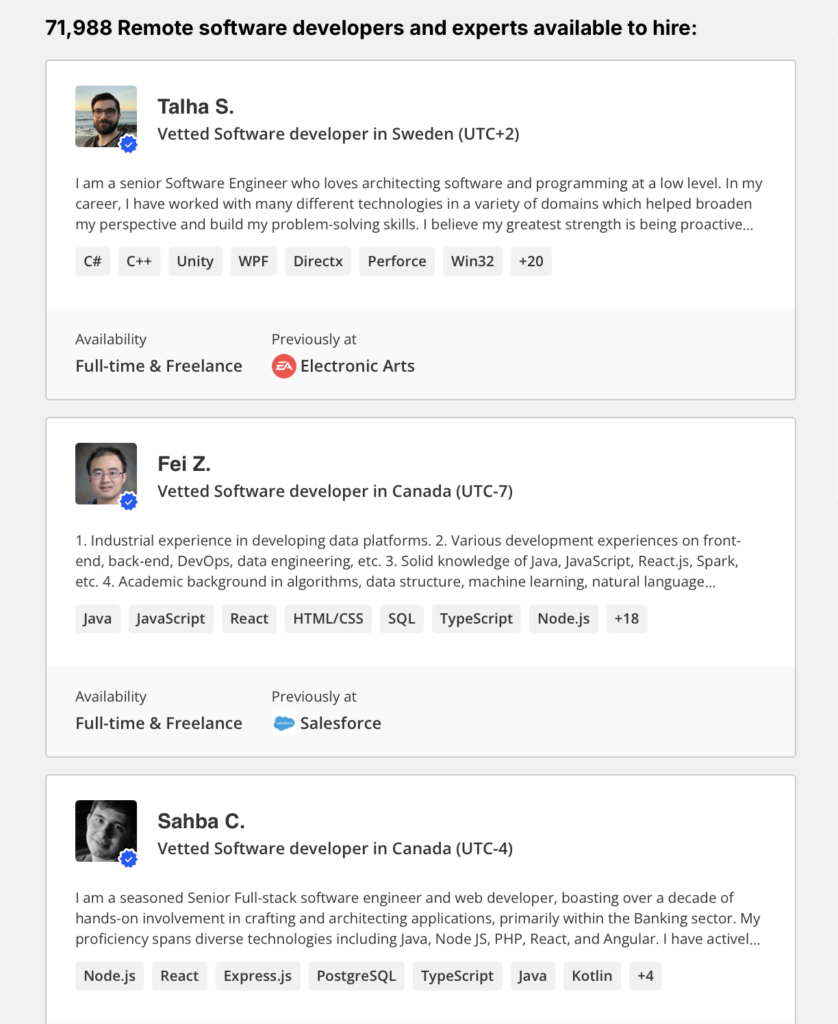
Arc.dev (formerly CodementorX) has invested heavily in technology to streamline the matching process, using AI to connect clients with relevant candidates quickly.
Strengths:
- AI-assisted matching: Its algorithms process thousands of profiles efficiently, though with occasional precision trade-offs.
- Enterprise compliance: Partnerships with platforms like Deel and Remote simplify cross-border hiring for larger companies.
- No deposit requirement: Unlike Toptal, Arc doesn’t require an upfront payment to begin the process.
- Brand recognition: Trusted by notable companies, including HubSpot, Splice, and Shopify.
Its vetting process includes profile screening, behavioral interviews, and technical assessments through pair programming. According to client testimonials, its main advantages are quality and price:

I’d share reviews from Trustpilot and G2, but all recent posts are from freelance devs.
Weaknesses:
- AI matching limitations: The algorithm sometimes prioritizes availability over exact skill fit, resulting in mismatched suggestions.
- Quality inconsistency: Several clients reported variable developer quality compared to Lemon.io’s more consistent results.
- The black box problem: Limited transparency into how its matching algorithm works can sometimes produce puzzling results.
Pricing is similar to Toptal, with developers typically charging $60-100+/hour, though without the additional platform subscription fee Toptal requires.
Squareboat
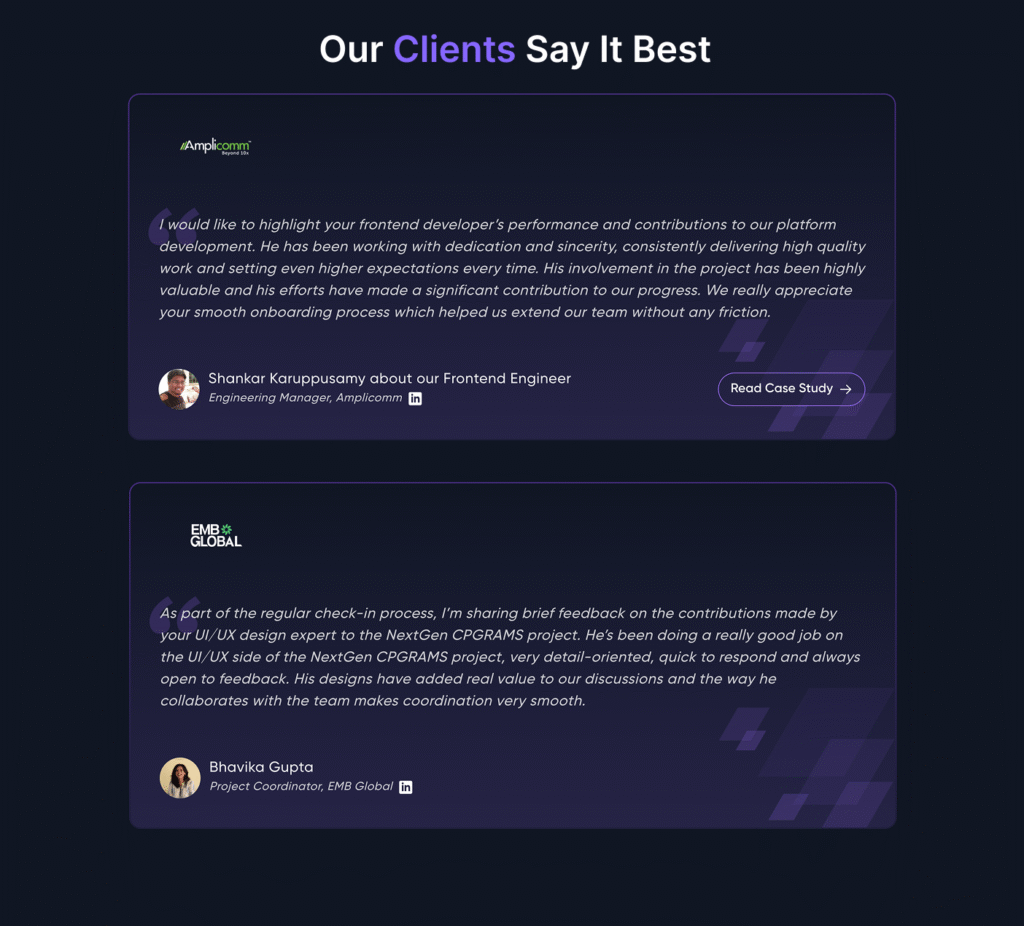
Squareboat is a design-first software development company offering IT staff augmentation services with in-house professionals—including developers, designers, QA engineers, DevOps specialists, and more rather than freelancers. This guarantees consistent performing and accountable talent that works as a seamless extension of your team. Every professional is rigorously vetted, AI-skilled, and trained for product environments. Clients also receive a dedicated project manager to oversee delivery and keep teams aligned. With resources delivering across multiple time zones, Squareboat has become a go-to choice for teams seeking highly skilled experts who deliver from day one.
Strengths:
- Squareboat provides in-house engineers with real, long-term product experience, ensuring consistent and dependable delivery.
- Every client is paired with a dedicated project manager who oversees progress and keeps communication effortless.
- With Squareboat, you get developers, designers, QA engineers, and DevOps specialists who can start immediately, with onboarding within 24 hours.
- The platform follows a fully transparent pricing model with no hiring fees, setup costs, or hidden charges.
- Clients can assess talent with confidence through a 7-day free trial before making any commitment.
With Squareboat’s IT staff augmentation services, teams can scale quickly without the usual hiring delays or administrative overhead. You gain access to in-house professionals without worrying about recruitment or background checks.

Weaknesses:
- Squareboat is designed for ongoing product work with dedicated engineers. Companies that want micro-tasks, quick fixes, or hourly freelancing won’t find a fit here.
- Dedicated engineers may hold specific project knowledge; replacing them mid-project may require ramp-up time.
Note: Best suited for long-term projects needing dedicated, skilled teams.
Upwork: The Mass Market Option
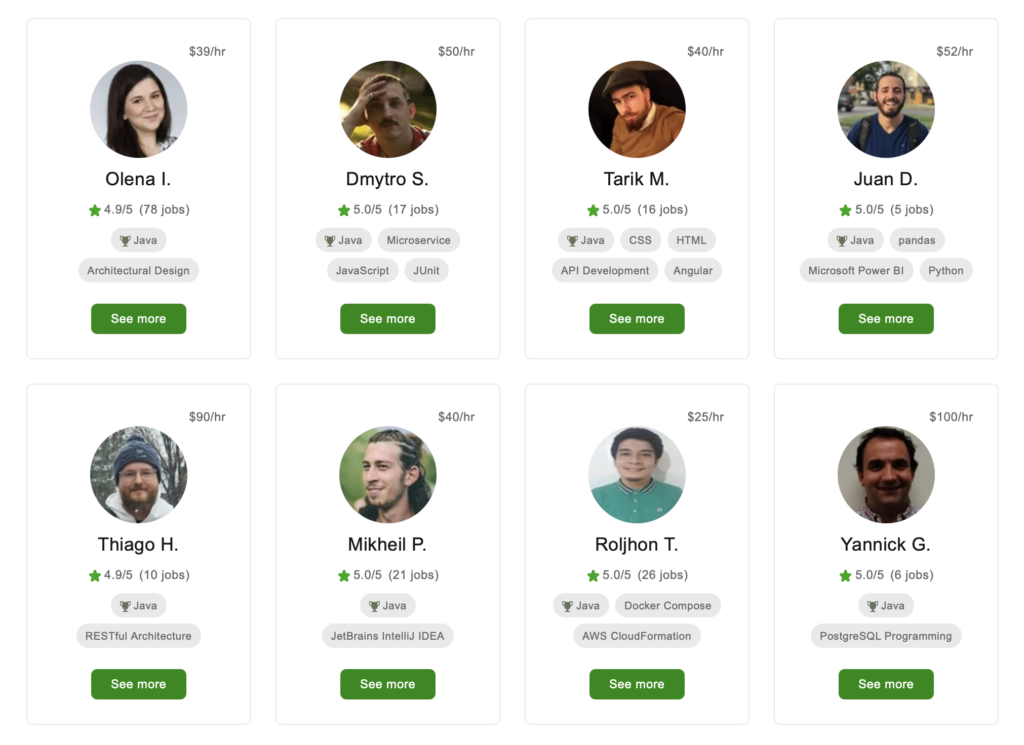
Despite its massive scale and general-purpose approach, Upwork remains relevant for companies with technical screening ability and budget constraints.
Strengths:
- Massive talent pool: Millions of freelancers across every imaginable skill set.
- Flexible pricing: Rates from $10 to $150+/hour accommodate various budgets.
- Complete control: Direct access to browse and filter candidates without platform interference.
- Integrated tools: Time tracking, escrow payments, and contract management all in one place.
Note: I’d share a screenshot of Upwork’s recent raving reviews, but . . . I couldn’t find any. It seems it has a community of livid freelancers and clients:
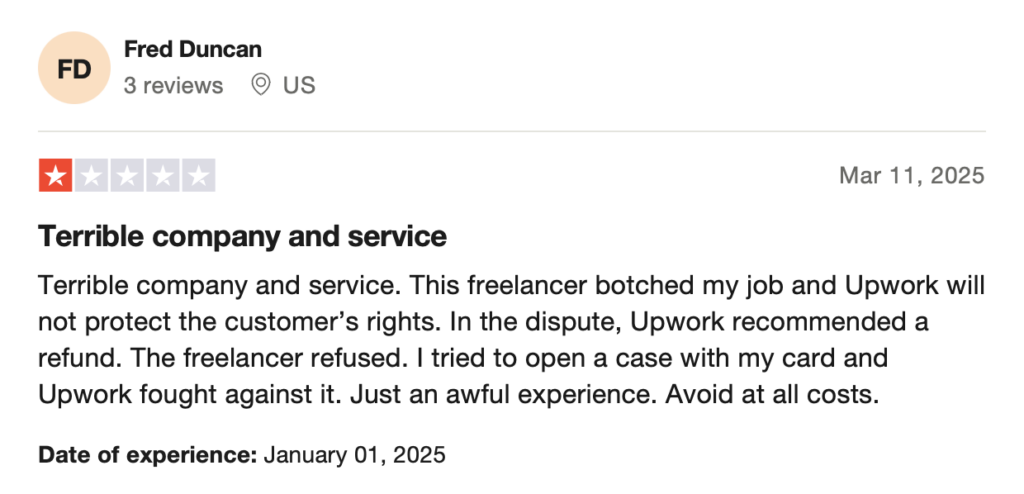
Weaknesses:
- Quality variability: Without standardized vetting, quality ranges from exceptional to abysmal.
- Time investment: Finding good developers requires significant screening effort.
- Review manipulation: “Top Rated” freelancers can remove negative reviews every three months, skewing reliability.
- Agency misrepresentation: Many “freelancers” are actually agencies where the person you interview isn’t who does the work.
The platform charges clients a service fee of up to 7.99% on each payment made to a freelancer. Freelancers pay a flat 10% service fee on all contracts, regardless of lifetime billings, as of May 3, 2023.
Fiverr Pro: Beyond the $5 Marketplace

Fiverr Pro represents Fiverr’s attempt to move upmarket with pre-vetted freelancers for clients with “higher expectations and budgets.”
Strengths:
- Package-based pricing: Clear deliverables and timelines with fixed prices.
- Portfolio emphasis: Strong visual representations of previous work.
- Fast turnaround: Often better for quick, discrete tasks than ongoing development.
Some clients show praise for the platform’s developer community:
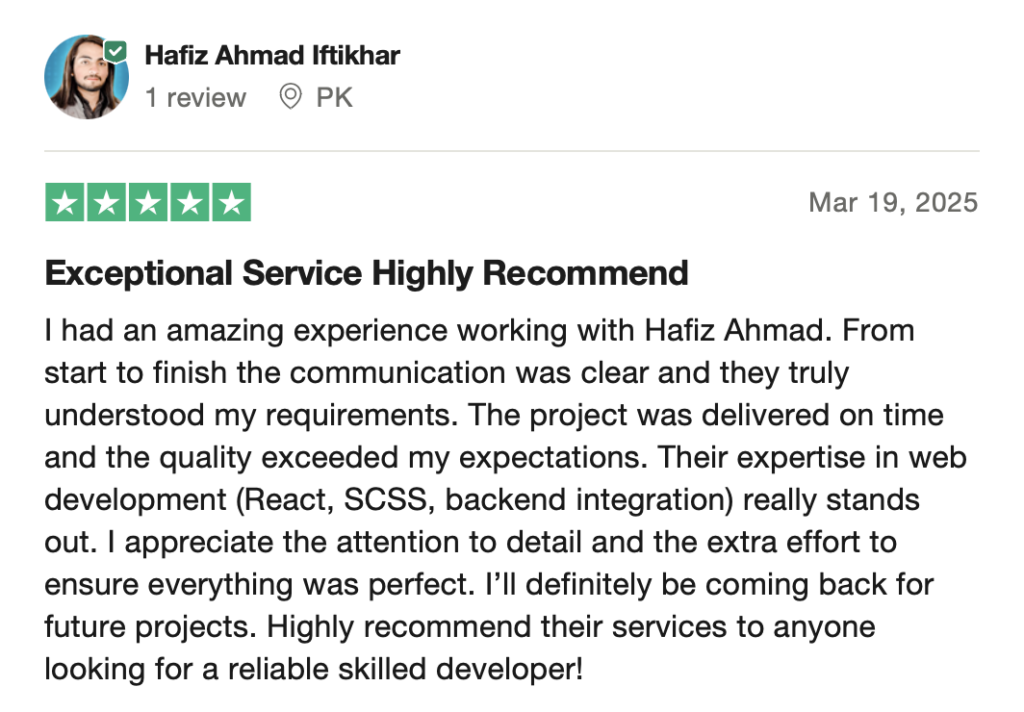
But for every positive review I found, I see dozens of negative reviews like this person who had their website damaged:
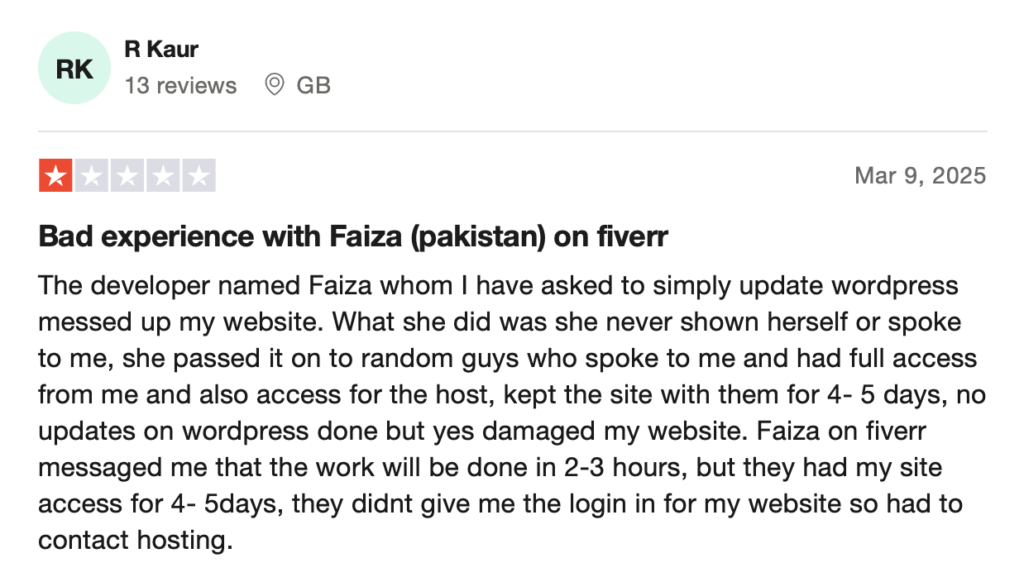
And this person who got stiffed and still had their money taken:
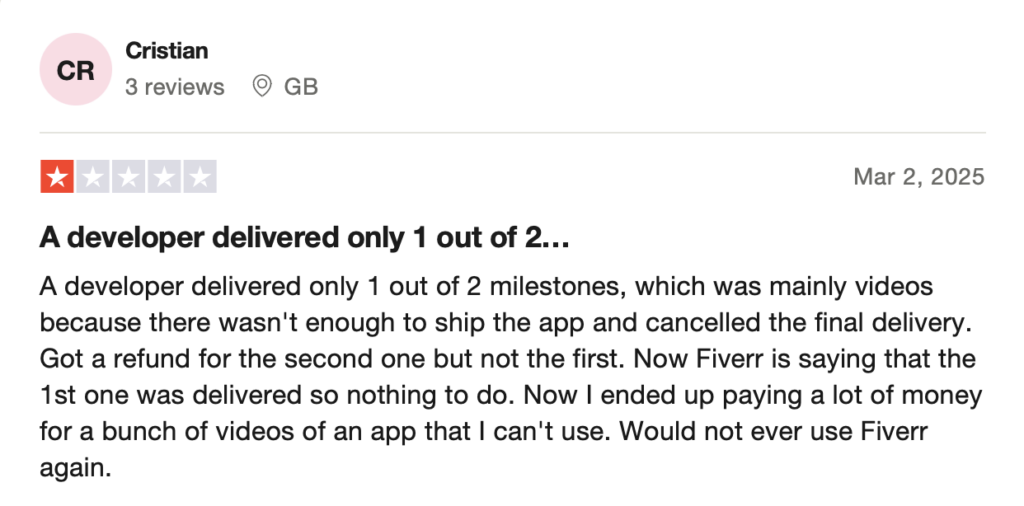
Aside from having talent issues, here’s a look at Fiverr Pro’s other problems.
Weaknesses:
- Limited complexity handling: Better suited for defined tasks than complex projects.
- Communication barriers: Less emphasis on collaboration compared to other platforms.
- Opaque vetting: The selection process for Pro status lacks transparency.
Fiverr Pro fees are also high by industry standards, with the platform taking up to 20% of transaction value, which can affect the quality of talent willing to remain on the platform long-term.
Gun.io: Technical Specialization with White-Glove Service

Gun.io offers a highly curated talent network with an emphasis on technical excellence and hands-on service.
Strengths:
- Thorough vetting: Three-stage technical assessment with emphasis on practical skills.
- Technical specialization: Particularly strong for complex technical challenges.
- U.S.-focused talent: Higher concentration of North American developers for timezone alignment.
As one satisfied client noted, ” Finding freelance support on short notice with specific skills or expertise was easy with Gun.io. We jumped on a call to provide them with details of what we needed, and they sent out ‘job postings’ to their extensive network to see if anyone could fit the bill. The overall cost was reasonable, and they were quick to communicate via email.”
Weaknesses:
- Premium pricing: Rates often exceed even Toptal’s premium pricing.
- Variable project management: Some clients report excellent management, while others describe a complete hands-off approach.
- Limited size: Smaller talent pool can mean longer waits for specialized skills.
Gun.io charges approximately 20% of a developer’s first-year salary for full-time placements, positioning them firmly in the premium segment alongside Toptal.
Developer Vetting: Who Actually Delivers Quality?
Vetting processes vary dramatically across platforms, impacting the talent you’ll encounter:
- Toptal runs one of tech’s most selective vetting programs, accepting 3% of applicants after thorough technical assessments and communication screening. Like any hiring process, results can vary, but its track record speaks for itself.
- Lemon.io uses what we call an “unapologetically thorough vetting process,” focusing on technical skills and communication abilities. Our smaller pool allows for more personal relationships with each developer, potentially explaining our high first-match success rate.
- Arc.dev employs a three-step process, including profile screening, behavioral interviews, and technical assessment. It claims to accept only the top 2% of applicants, though our research found less consistency in match quality compared to Lemon.io.
- Upwork skips the vetting and lets anyone call themselves a developer. Hope you enjoy spending your afternoons fact-checking resumes and running technical interviews—because that’s now your full-time job.
The key insight: Rigorous vetting processes don’t automatically guarantee perfect matches. Platforms with personal knowledge of their talent pools (like Lemon.io) often deliver more consistent results than those relying purely on standardized testing or AI matching.
Pricing and Cost Comparisons
When evaluating platforms, the advertised rates are just the beginning. My investigation uncovered significant differences in fee structures and hidden costs.
Pricing Factor |
Toptal |
Lemon.io |
Arc.dev |
Upwork |
Gun.io |
|---|---|---|---|---|---|
Developer Rates |
$65-100/hr for frontend, $80-200+/hr for specialists |
$45-120/hr depending on specialization |
$60-100+/hr for standard development |
$10-150+/hr depending on experience and location |
$75-110/hr for mid-level, $110-145/hr for senior developers |
Additional Fees |
30-50% markup on developer rates |
More competitive margins |
One-time placement fee—20% of candidate’s 1st-year salary |
5% client fee + up to 7.99% payment processing |
None |
Deposits/ |
$500 mandatory deposit |
No deposits required |
$300 deposit |
No deposits required |
No upfront fees, but minimum 20 hours/week commitment |
Subscription Costs |
$79 monthly platform access fee |
No subscription fees |
No subscription fees |
No subscription fees |
No subscription fees |
This pricing comparison reveals why many companies are exploring Toptal alternatives. While Toptal offers premium talent, its additional fees and commitments can significantly increase the total cost of engagement compared to platforms like Lemon.io that offer similar quality without the hidden expenses.
Recommendations Based on Different Hiring Needs
For Startups and Early-Stage Companies
Best option: Lemon.io stands out as the ideal choice for startups and scale-ups. Our focus on startup experience means developers understand the unique challenges of early-stage companies. Our two-week matching time and transparent pricing also align well with startup and scale-up company needs.
Runner-up: Arc.dev offers a viable alternative with quick matching, though with less emphasis on startup-specific experience.
For Enterprise and Established Products
Best option: Toptal remains competitive here despite the premium pricing. Its large global pool increases the chances of finding specialized enterprise skills, and its documentation and process-heavy approach align with enterprise needs.
Runner-up: Arc.dev with its enterprise compliance features and partnerships with platforms like Deel and Remote that simplify international hiring.
For Technical Teams Expanding Capacity
Best option: For technical teams with screening capacity, Upwork offers the best value opportunity. The ability to directly evaluate candidates allows you to find high-quality developers at reasonable rates, though at the cost of significant time investment.
Runner-up: Lemon.io balances control with time efficiency, providing transparency into developer profiles while handling initial vetting.
For Non-Technical Founders
Best option: For non-technical founders, Lemon.io offers the best balance of quality assurance and reasonable pricing. Its human-centered vetting and startup focus ensure developers can bridge the technical-business gap effectively.
Runner-up: Toptal, though at higher cost, provides similarly vetted talent with business understanding.
For Specific Technical Challenges
Best option: For highly specialized technical needs, Gun.io’s technical focus can be worth the premium pricing. Its emphasis on deep technical expertise makes it suitable for complex engineering challenges.
Runner-up: Toptal’s large pool increases the chances of finding niche expertise, though matching precision may vary.
Choosing the Best Alternative to Toptal
After months of research, interviews, and hands-on testing, several clear conclusions emerge about today’s developer hiring landscape:
- No single platform serves all needs perfectly. Each has distinct strengths that align with different company profiles and project types.
- Vetting processes vary dramatically in approach and effectiveness. While Toptal pioneered rigorous screening, others like Lemon.io have developed equally effective approaches focusing on soft skills and startup relevance.
- The true cost of hiring extends far beyond hourly rates. Platform fees, minimums, deposits, and other requirements can significantly impact the total investment.
For most innovative companies, especially those building new products or expanding technical capabilities, Lemon.io offers the most compelling alternative to Toptal in 2025. Our combination of thorough vetting, startup-relevant experience, transparent pricing, and personalized matching addresses the primary pain points that drive companies to seek Toptal alternatives.
Companies with enterprise needs may find value in Toptal’s approach. Technical teams comfortable with screening their own candidates can extract excellent value from Upwork with sufficient time investment. And those with specialized technical challenges might find Gun.io’s focus worth the premium pricing.
If you’re still uncertain, consider starting with a small trial project on your top two contenders. This practical comparison will reveal which platform truly delivers for your unique needs—because in developer hiring, experience speaks louder than promises.
Do you want to check more reviews? Check here.









